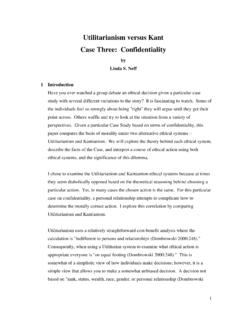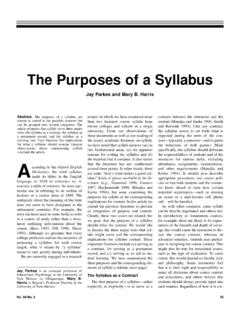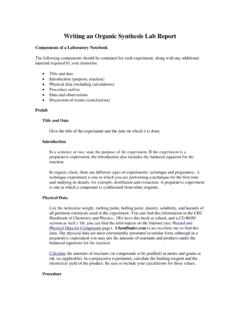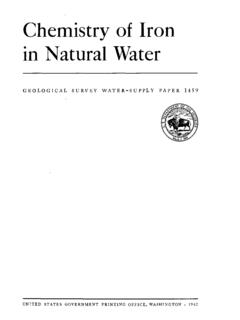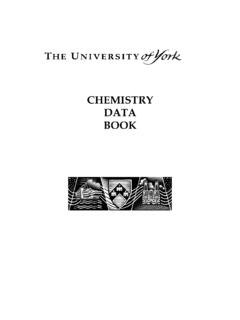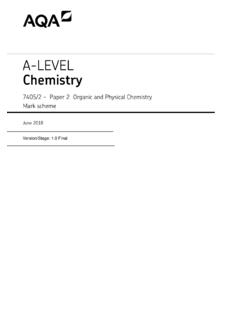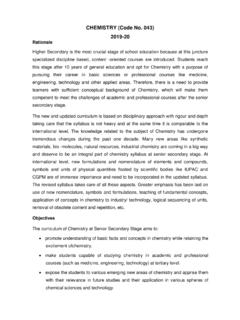Transcription of Experiment 1 - Melting Points - NAU jan.ucc.nau.edu web …
1 Experiment 1 - Melting Points Introduction The Melting point of a substance (the temperature at which a substance melts) is a physical property that can be used for its identification. It is a measure of the amount of kinetic energy (heat) that must be supplied to the particles of the substance in order to overcome the intermolecular forces (such as Van der Waals, dipole-dipole, and H-bonding) that confine them to the solid state. The determination of Melting Points is particularly important to organic chemists, since they often work with solid molecular compounds that have low Melting Points (below 300 C) and which can be conveniently measured.
2 organic compounds are used in this Experiment for the same reasons. Melting Points are also used as an indication of purity. Substances melt throughout a temperature range in which both the solid and liquid phases of the substance coexist in a state of equilibrium. Above that range, the substance exists only as a liquid, and below it only the solid phase is present (no wetness observed). The extent of this temperature range is a measure of the purity of the substance; that is, impure samples of compounds have lower and broader temperature ranges of Melting .
3 If a pure sample of a compound melts from 110 to C, the addition of substantial amounts of another compound might result in a new Melting point range from 85 to 100 C. An identical or near identical temperature range of Melting is not, in itself, proof of the sameness of two organic chemical samples. There are thousands of solid organic compounds that melt within any relatively short temperature range; overlap of Melting Points is therefore inevitable. If an unknown solid sample is believed to be a certain known compound, it is a relatively simple task to prove or disprove this belief by mixing the known and unknown together in relatively equal quantities.
4 A 50:50 mixture will either be a pure sample of the known compound or a highly impure sample of the known compound. The Melting point of the mixture will be identical to that of the known compound in the first instance or lowered and much broadened in the latter. This identification/confirmation procedure is referred to as the determination of a "mixed" Melting point. The Determination of Melting Points Melting Points will be determined by using one of the DigiMelt units (Figure ).
5 The DigiMelt units must always be kept upright. Place a small quantity (1/16 inch in tube) of the solid to be melted in a capillary tube (labeled Melting point tubes). Tap the closed end of the tube on the desk, clean the outside, and use the tamper of the right side of the DigiMelt to compact the solid down to the closed end of the Melting point capillary tube. Drop the tube (closed end down) down a section of glass tubing (see TA) to compact the solid in the bottom or closed end of the tube even more. Place the tube loaded with the sample into the sample holder of the DigiMelt with the closed end down.
6 The crystals can be ground up in a clean and dry mortar and pestle if they are too big to fit into the capillary tube. If the Melting point of the sample is unknown or unavailable, a fast run with the DigiMelt set at a ramp of 10 or 20 C per minute to obtain an approximate Melting range. A more precise value can then be obtained by heating the DigiMelt more slowly at a slower ramp (about 2 C/min.) starting 5-10 degrees below the temperature at which your sample first began to melt. Figure : The DigiMelt apparatus.
7 Melting point capillary tubes are placed (closed end down) in the slots directly in front of the magnifying lens where they are viewed during Melting . Up to three samples can be viewed at once. The heating rate of the DigiMelt is adjusted by setting a temperature ramp along with a start and end temperature following the "Quick Start Instructions" on the front of the DigiMelt. A ramp of 20 C per minute will result in a rapid temperature rise while a ramp of say 2 C per minute will give a slower rise that will more accurately measure the Melting range of a solid.
8 Record the temperature that the crystals begin to melt (crystals will look wet) and the temperature at which the substance becomes a clear liquid with no solid material remaining. This is the Melting range. The DigiMelt provided a digital readout of the temperature. Equipment is not calibrated and may be off as much as 3 oC. Consequently, do not expect the Melting Points obtained with the DigiMelt apparatus to be identical to those listed in the Table shown on page 3. The calibration of the DigiMelt thermometer will be checked using the Melting range obtained for pure urea or pure cinnamic acid.
9 Use the same DigiMelt for all your measurements. The Experiment Prelab Work: Answer the prelab questions at the end of this write-up on a piece of loose leaf paper (not in lab notebook) after you have read the Experiment . A quiz will be given at the start of the period covering the introduction and this Experiment in the laboratory manual, any lab lecture material from last week or this week, and the prelab questions. Laboratory Notebook: Be sure to read the section on the laboratory notebook in the introduction of the laboratory manual.
10 All data, calculations, observations, and conclusions should be recorded directly in the laboratory notebook. Be sure to save the first two pages of the notebook for a table of contents. Results for unknowns are reported by filling a report sheet found at the end of the Experiment and giving the sheet to your TA or stockroom (216). Supplies: DigiMelt, Capillary Tubes (closed end), mortar & pestle, cinnamic acid, urea, and chemicals in the table below. If possible, use the same DigiMelt for all your work.

